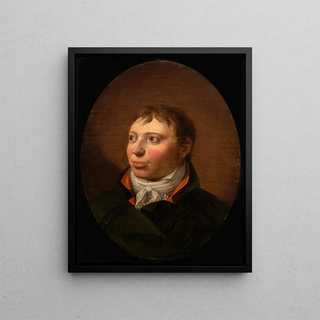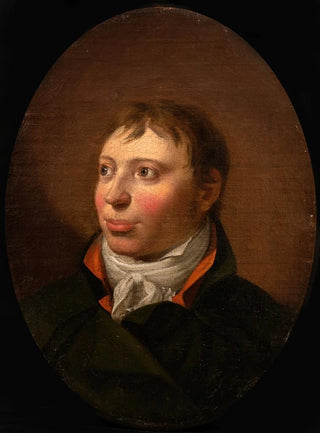Painting Portrait of a Man - Christoffer Wilhelm Eckersberg


View from behind

Frame (optional)
Christoffer Wilhelm Eckersberg's "Portrait of a Man" presents itself as an open window into 19th-century Danish life, an era marked by artistic and intellectual vibrancy. This iconic artwork, created by one of the pioneers of realism in Scandinavia, embodies not only exceptional technical skill but also a psychological depth that invites contemplation. Through this portrait, Eckersberg does not merely depict an individual; he captures the very essence of his time, making palpable the soul of a man while reflecting the concerns and aspirations of a society in transition.
Style and uniqueness of the work
Eckersberg's style is characterized by meticulousness and precision that go beyond the simple act of painting. In "Portrait of a Man," every detail, from the fold of the clothing to the expression on the face, is carefully crafted, demonstrating attentive observation and mastery of pictorial techniques. The artist employs a subtle color palette, playing with light and shadow to bring his subject to life. This realism, combined with a certain idealization, creates a delicate balance between naturalness and aesthetics. The gaze of the character, both intense and distant, seems to invite the viewer to question his personal history, his thoughts, and his emotions. This ability to evoke a deep human connection makes this work a key piece in portraiture, where each brushstroke tells a story.
The artist and his influence
Christoffer Wilhelm Eckersberg, often regarded as the father of Danish realism, managed to leave his mark on his era through an innovative approach to painting. Trained at the Royal Danish Academy of Fine Arts in Copenhagen, he was also influenced by his stays in Paris, where he mingled with the great masters of his time. His work played a decisive role in the evolution of Danish art by introducing contemporary themes and moving away from academic conventions. Eckersberg thus paved the way for a new generation of artists, encouraging a freer exploration of reality and the individual. His impact endures today, and his work continues to inspire not only artists but

Matte finish

View from behind

Frame (optional)
Christoffer Wilhelm Eckersberg's "Portrait of a Man" presents itself as an open window into 19th-century Danish life, an era marked by artistic and intellectual vibrancy. This iconic artwork, created by one of the pioneers of realism in Scandinavia, embodies not only exceptional technical skill but also a psychological depth that invites contemplation. Through this portrait, Eckersberg does not merely depict an individual; he captures the very essence of his time, making palpable the soul of a man while reflecting the concerns and aspirations of a society in transition.
Style and uniqueness of the work
Eckersberg's style is characterized by meticulousness and precision that go beyond the simple act of painting. In "Portrait of a Man," every detail, from the fold of the clothing to the expression on the face, is carefully crafted, demonstrating attentive observation and mastery of pictorial techniques. The artist employs a subtle color palette, playing with light and shadow to bring his subject to life. This realism, combined with a certain idealization, creates a delicate balance between naturalness and aesthetics. The gaze of the character, both intense and distant, seems to invite the viewer to question his personal history, his thoughts, and his emotions. This ability to evoke a deep human connection makes this work a key piece in portraiture, where each brushstroke tells a story.
The artist and his influence
Christoffer Wilhelm Eckersberg, often regarded as the father of Danish realism, managed to leave his mark on his era through an innovative approach to painting. Trained at the Royal Danish Academy of Fine Arts in Copenhagen, he was also influenced by his stays in Paris, where he mingled with the great masters of his time. His work played a decisive role in the evolution of Danish art by introducing contemporary themes and moving away from academic conventions. Eckersberg thus paved the way for a new generation of artists, encouraging a freer exploration of reality and the individual. His impact endures today, and his work continues to inspire not only artists but
12,34 €






